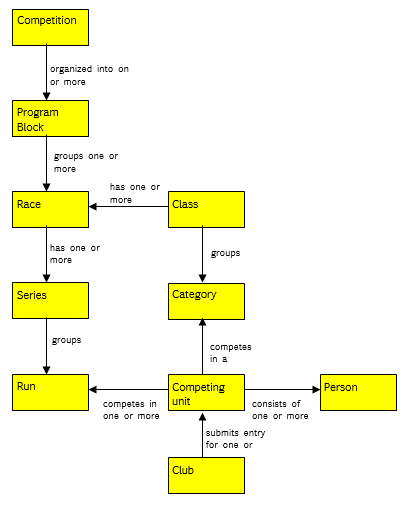canoe / kayak slalom competition software
Data model overview
| |
 Functional overview Functional overview System overview System overview Technical overview Technical overview Data model overview Data model overview
|
This overview presents the main tables of Ariadne.

figure 1: the main Ariadne tables
Competing units
The competing unit is the unit which competes in a race. The competing unit consists of one person in case of a K1 or C1, of two persons in case of K2 or C2, and of more persons in case of a team ( 3 persons with 3*K1 and 3*C1, 6 persons with 3*C2, and other numbers with fancy teams). A competing unit is submitted by a club in an entry. A competing unit is assigned one start number (bib).
A person can compete in more competing units (limited by the categories wherein a person can compete).
(Competing unit and Entry refer to the same object. An Entry is an administrative procedure for submitting a Competing unit.)
Categories and Classes
In Ariadne a Competing unit is not directly assigned to a Race, but via a Category and a Class. A Category is a performance class on basis of gender (men, women), age ( senior, junior, master etc.), boat type (K1, C1, C2 etc.), and performance level.
Categories have quite a level of detail. It may be that for some categories there are not suffient entries to have a valid race. In that case more categories will be grouped into one class, until the class has sufficient entries to have a valid race. The grouping of categories into classes is decided by the competition committee.
The opposite may happen also, when more entries for some categories were received that expected, and that a class containing more categories will be split into two classes.
The Category - Class distinction also enables to assign a category to more classes, thus creating virtual classes and races. With this mechanism you can extract and combine results from different actual races into a new ranking. For example to extract some special championship ranking from regular races.
Races, Runs and Series
A Race is a performance meeting, in which the performances of competing units from a class are measured and ranked. The competing unit with the best performance is the winner of the race.
The performance of a competing unit in a race is measured in one or more Runs. A run is the performance measurement of one competing unit (in terms of runtime or runtime plus penalties). It may take more runs to get a ranking for a Race. The way runs results are processed into race results may vary (e.g. best of two runs, sum of two runs).
A Class can have more Races. This is the case when there there are more competing stages in terms of heats and finals.
A Race has one or more Series. A Series is a series of runs. When the competing unit has two runs, the race has a Series 1 and a Series 2.
In a Series the competing units start in a start order. The start order is related to the performance ranking of the competing units (on basis of historical data), and whether the entry was a late entry. (Late entries sort at the beginning of the start list).
Program blocks
Races are grouped into Program Blocks. Program Blocks are a way te organize competitions. In a program block first the Series 1 of the related races are executed, and next to it the Series 2. A program block covers mostly a few hours. Between the program blocks, pauses can be scheduled, for lunches, for checking the course, for changing gate sections etc.
Clubs
An entry is submitted by a club. (An entry may not necessary already have persons, as a team entry can be submitted by a club for which the persons are not already known in advance.) For entry confirmation, a team leader / contact person must be known from the club. The entry fees are invoiced to the club.
Persons
Persons can have more roles. The main role is the competitor role, as partaking in a competing unit. Other roles are team leader, a clubs contact person, and officials.
The minimum data Ariadne need to know of a person is name and gender. Additional data can be registered for age class and performance level. Only in his/her role as competitor or official, a person is related to a club.
In the Ariadne-archive the competitor and official history of persons is kept. This provides a historical view of performances of the relation between persons and clubs.
last updated: Jan2016